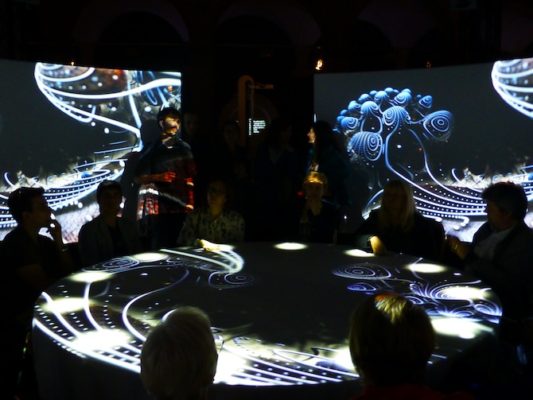Search
To search for an exact match, type the word or phrase you want in quotation marks.
A*DESK has been offering since 2002 contents about criticism and contemporary art. A*DESK has become consolidated thanks to all those who have believed in the project, all those who have followed us, debating, participating and collaborating. Many people have collaborated with A*DESK, and continue to do so. Their efforts, knowledge and belief in the project are what make it grow internationally. At A*DESK we have also generated work for over one hundred professionals in culture, from small collaborations with reviews and classes, to more prolonged and intense collaborations.
At A*DESK we believe in the need for free and universal access to culture and knowledge. We want to carry on being independent, remaining open to more ideas and opinions. If you believe in A*DESK, we need your backing to be able to continue. You can now participate in the project by supporting it. You can choose how much you want to contribute to the project.
You can decide how much you want to bring to the project.

Now that we know we are living in an overgrown Lloret de Mar, we can just get drunk on sangria with straws that are half a metre long and watch the world go by. There is a place in Las Ramblas that instead of sangria serves nothing tangible, it’s called Arts Santa Mónica, where currently there is installed what is declared to be the latest in culinary sophistication. We already know that since Saint Ferran Adrià, Catalan cuisine has become international, being deconstructed and reconstituted, as many times as there are gas cookers. And the Roca brothers have won the Pulitzer of gastronomy and that, as a country, we now play in the “premier league” for the maridaje of food and wine, with all the added value that this implies for the branding of the country, though the majority go straight from the airport to the restaurant.
Arts Santa Mònica is soon to become the latest creation from the kitchen of the council of Culture; a place, they say, to activate creation and function like the council’s radar, to capture talent. This particular Sónar of the Generalitat will be directed by the flamboyant Director General of Creation and Cultural Industries, Jordi Sellas and enlivened by the leading DJ’s, Juan Magan and Sak Nowel, the latter being the author of the top hit “gente loca” (mad people). Hey, it’s just “Johnny, the people are very loka!”
Well in this very same place, in Arts Santa Mònica, is installed in the cloister the spawn of the Roca brothers and company. Recently David G. Torres already offered a first taste , of the perversity of an experiment that involved convening a certain cultural elite to a grand banquet. I can’t imagine the diners conversing, without the echo of Martí Peran’s words, about the court of Mantua and the self-referential nature of our local art resounding in my ears. A form of self-absorption worthy of the most decadent eras of creation and if you will allow me, one that delves into that Catalonia in Miniature of the Pujol era . It’s just that’s where we are, entrenched in the systematic elimination of Culture centres, amongst which one finds Arts Santa Mònica itself, and the implantation of an ideological programme of the most provincially minded Convergencia i Unió, embodied by the two headed monster, Pilar Rahola and Núria Feliu. I would add to this, the other front, the independence process that many in the art world feign doesn’t exist.
Carrying on: there is a round table surrounded by four semi-circular screens and some devices that emit sounds. The public congregates there, some can sit down and the spectacle begins. The table and the screens show a video-creation that intersperses Catalan landscapes, such as burnt forests or the Palau de la Música (at least with this they’ve hit the mark) with digital images of fruit, abstractions and even a Pietas (though this pietas is sexy, the body of Christ resembles David and the Virgin, in the computerised image is a young girl with rounded out breasts). There is music, sound and a voice in off that recites the plates and drinks that the diners supposedly swallow. One can only suppose because here, unlike the real experience that a privileged few had the pleasure of enjoying, there is neither bread nor wine. The interactive opera reaches its peak when those that are seated can manipulate the screen-table to push away some drops of blood-wine. This is the drop that is just the last straw: how dare they sell us this as a feat of sensorial participation? The experience is null, false and void. It doesn’t smell nor taste of anything.
And there they are, idyllically ruminating, with a certain air of a crise-2013 version of those Portabella “Suquet” evenings, a gathering of names of the country’s cultural representatives, mutually satisfied to know each other, including the curator who earns more than 100.000€ of public money per project. Amongst those seated, the odd one wears the kind of expression that appears in spiritualist sessions. Hands on the table, calling upon the ghosts of times past. Rosó, Rosó… I just can’t help thinking of another illustrious figure from the Ampurdà, Don Josep Pla, who no doubt as a ghost is turning in his hell’s kitchen, due to the “collonades” of his fellow countrymen. As it’s just that “El Somni” of Can Roca employs a loaded and artificial language to hide what simply isn’t there. Bon Profit i Bona Cuina!

Xavier Acarín is fascinated with experience as the driving force of contemporary culture. He has worked in art centres and cultural organizations both in Barcelona and New York, focussing in particular on performance and installation.
"A desk is a dangerous place from which to watch the world" (John Le Carré)